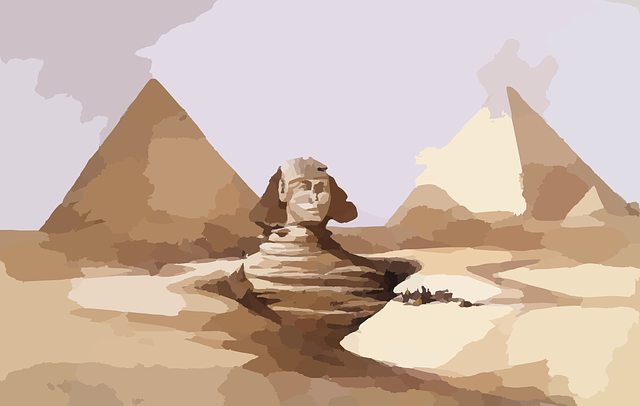The great pyramids are an architectural wonder that has captivated the people since the time of their creation. Built about 4500 years ago, the pyramids of Giza are the great relics of the Old Kingdom of Egypt, and they represent the grandeur of one of the greatest and most advanced ancient civilizations in the history of humankind. The question that has haunted many historians is, how were these great structures constructed without the use of machinery? Even to this very day, the secrets of the pyramids are still yet to be discovered.
How were the great pyramids built?
Over the years, archaeologists have been able to determine how the pyramids built. According to historical findings, the workers who built them were well-fed Egyptians who lived in a temporary city nearby. This civilization was highly skilled and organized and much more advanced for their time. It also seems that the Egyptians operated under a very authoritarian leader, and even history gives testimony to it. Many historians have recorded that the pyramids were built by transporting blocks of rocks from as far as 600 miles by The Nile River. A level surface was prepared, and the stones taken to Giza. The stones were moved using rolling logs and were taken on the site where stonemasons were ready to start prepping the slabs. The pyramids are built in the way that once the four sides were completed, another layer was added to the top, which had a smaller perimeter than the previous one but was higher from the ground.
It is a marvel how these heavy stones were carried to the top. Although there are no photos available, archaeologists have come up with two possible theories; either side ramps made of wood or earth were constructed and used, or earthen ramp was created on one side of the pyramid. Whatever the case, the building of the pyramids required thousands of men and took decades to complete. Interestingly, according to the historical facts, the concept of slavery was prevalent in the Egyptian civilization, yet after the tombs of the workers (who built the pyramids) were discovered, it was concluded that they were paid laborers and not slaves. These findings certainly discredit the theories that suggested that aliens built the pyramids!
Great pyramids of Giza
The great pyramids of Giza include three pyramids, the largest one built by the Pharaoh Khufu took approximately 23 years to be built. The great pyramids of Giza are estimated that 342 stones were moved daily. It took about 2500,000 stones to complete this great piece of architecture. What makes this process such a marvel is the fact that all this was done without the use of any sort of machinery. The interior of the pyramids, especially the one built by Khufu, is commendable.
The interior design of the pyramid is rather systematic and perhaps the key to why so many relics were found preserved (at least those that didn’t fall in the hands of the robbers). There are multiple air shafts that are connected to the king’s chamber so that, even though once the pyramids were sealed after the burial, there was some sort of ventilation. Considering this was thousands of years ago, and saying that the Egyptians were anything less than intelligent would be an insult to them. It is highly commendable that such an ancient civilization can be studied, and the credit goes to the way they preserved their history for all times to come. Their architecture, drawings, symbols, heliographs, and old relics and artifacts have contributed significantly to the recent studies on the pyramids.
As mentioned earlier, the pyramids were built as the burial chambers for the great pharos, and it was believed that the Egyptian pharos would rise as gods in the afterlife. So they filled their burial chambers with gold and silks and an entire entourage of slaves to serve them in the afterlife. Many such artifacts have been discovered and restored, including sarcophaguses, mummies, and many gold ornaments and such from the pyramids of Giza.
Recent discoveries:
It should not be surprising that unveiling the secrets of the pyramids has taken such a long time and that much more historical artifacts are still waiting to be found. The architecture of the pyramids is sophisticated and complex. For instance, the latest technology known as the snake robot has been created, which allows for the historians to look inside the areas of the pyramid, which are otherwise inaccessible, resulting in the discovery of secret passages, chambers, and shafts. The great pyramid has three chambers; the base chambers, the Queen’s chamber, and the king’s chamber. Two tunnels are leading from the Queen’s chamber, but they are only 20cm in width and height. Moreover, many doors have been discovered of length and widths that cannot be used, and according to Egyptologists, as Kate Spence suggests that these doors and markings are more for illustrative purposes than practical use. If they can decipher the hieroglyphs (that they found), they would be able to determine what these passages and these shafts mean more accurately.
Conclusion:
People often seem to think that the pyramids show us how the Egyptians died, but it is so much more than that. Inside the pyramids, you can find a graphic representation of almost all aspects of their daily lives, and so it is not just about how they died but how they lived. Every year people from all over the world come to visit the great pyramids of Giza, and under the starry skies in the desert, you can almost feel the ancient civilization come to life.
References
Secrets of the Great Pyramid Revealed At Last!! 5th September 2015. Web. http://www.reformation.org/secrets-of-the-great-pyramid-revealed.html
Handwerk, Brian. Giza Pyramids Hold Pharaohs’ Ancient Secrets. Natural Geographic. 5th September 2015. Web. http://science.nationalgeographic.com/science/archaeology/giza-pyramids/
Radford, Benjamin. How Were the Egyptian Pyramids Built? LiveScience. 1st June 2010. 5th September 2015. Web. http://www.livescience.com/32616-how-were-the-egyptian-pyramids-built-.html












